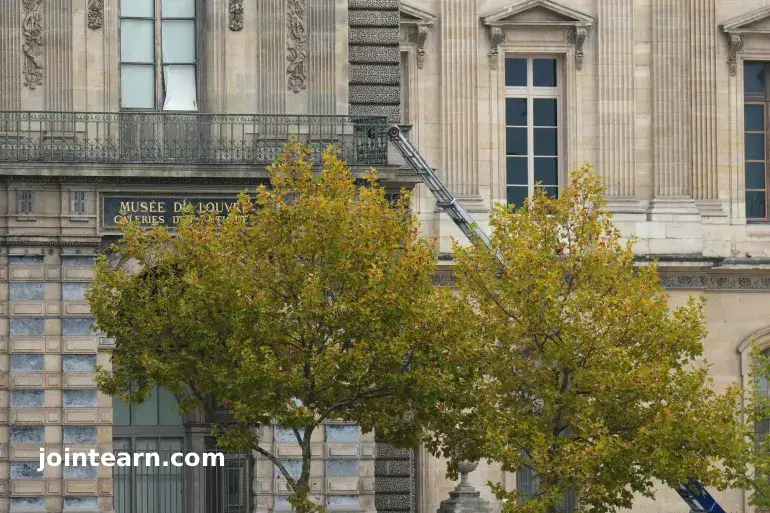
In a shocking and meticulously planned robbery, thieves armed with power tools stormed the Louvre Museum in Paris on Sunday morning, stealing “priceless” jewels from the museum’s famed Galerie d’Apollon, home to France’s historic crown jewels. Authorities say the heist lasted just four minutes and has prompted the temporary closure of the world’s most-visited museum.
The Four-Minute Robbery That Stunned Paris
According to the French Ministry of the Interior, the thieves struck shortly after 9:30 a.m. (07:30 GMT) — a time when the museum had already opened to visitors. Using heavy machinery and power tools, they accessed the Galerie d’Apollon, which houses jewels once belonging to Napoleon and Empress Eugénie.
Authorities described the operation as “highly professional” and confirmed that no injuries were reported among visitors, museum staff, or security forces. A detailed inventory of the stolen items is currently underway.
“Beyond their market value, these jewels hold priceless cultural and historical importance,” the ministry said in a statement.
How the Thieves Pulled It Off
French Interior Minister Laurent Nunez told France Inter radio that the criminals used a basket lift to reach one of the museum’s upper windows, where they cut through the glass using a disc cutter. The group then entered the gallery, seized the jewels, and escaped on motorbikes, disappearing into the busy streets of central Paris.
Culture Minister Rachida Dati confirmed that the entire heist lasted “almost four minutes”, emphasizing the speed and precision of the perpetrators.
“We came immediately after being alerted, but it was over in minutes. These were professionals,” Dati said.
One of the stolen jewels — a crown belonging to Empress Eugénie — was found broken outside the museum, indicating the thieves may have dropped it during their escape.
Louvre Closed for “Exceptional Reasons”
Following the robbery, the Louvre announced on X (formerly Twitter) that it would remain closed for the day “for exceptional reasons.” Police quickly sealed off the area, closing surrounding roads and locking the museum’s gates.
Videos posted online showed confused tourists gathering outside the museum as officers and forensic teams began their investigation.
The Galerie d’Apollon, where the theft occurred, is one of the Louvre’s most celebrated spaces — its opulent, gold-trimmed ceilings and jewel displays draw millions of visitors annually.
A Museum with a History of Heists
The Louvre has been the target of several high-profile thefts throughout its long history.
- In 1911, the museum’s most famous artwork, the Mona Lisa, was stolen by an employee and later recovered two years later in Florence, Italy.
- In 1983, two pieces of Renaissance-era armor were stolen and remained missing for nearly 40 years before being recovered.
The latest heist follows a spate of museum burglaries across France.
Just last month, robbers stole €600,000 ($700,000) worth of gold samples from Paris’s Natural History Museum, using an angle grinder and blowtorch. In another case, thieves smashed display cases with axes and baseball bats at the Cognacq-Jay Museum, escaping in broad daylight.
Investigation Underway
Paris police have launched a major investigation involving the Brigade de Répression du Banditisme (BRB) — France’s elite anti-gang unit — to track down the thieves and recover the stolen jewels.
Authorities are reviewing security footage from the Louvre and surrounding districts, as well as nearby bridges and streets along the Seine River, to trace the criminals’ escape route.
“These jewels are part of France’s national heritage,” said one police official. “We are treating this as a top-priority case.”
Global Shock Over the Heist
The theft has sparked outrage and disbelief among art lovers and historians worldwide. Many have questioned how such a high-security museum could be breached so quickly.
Experts note that ongoing construction work on the Louvre’s Seine-facing façade — the same side used by the thieves — may have inadvertently weakened security in that section.
As authorities race to recover the missing artifacts, the Louvre’s latest security breach adds to a growing list of cultural heritage crimes shaking France’s art institutions.
Leave a Reply